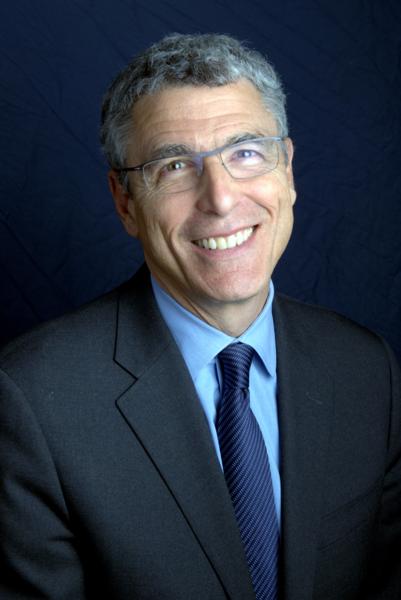Like our ancestors, we focus on our own modern day tribes: The tribes of the Reform, Conservative, Orthodox, Reconstructionist, and secular. Amidst our real differences, can we sew ourselves together into a larger identity of being Am Yisrael – one people?
Rabbi Rick Jacobs, president of the Union for Reform Judaism, discusses these themes in this week's Torah portion, Parashat B'midbar.
Four ways to tune in:
- Watch the video snapshot below
- Listen to the full podcast below
- Subscribe to the podcast on iTunes
- Suscribe to the RSS feed
- Transcript
[URJ Intro:] Welcome to Episode 20 of “On the Other Hand: 10 Minutes of Torah,” a podcast presented by ReformJudaism.org. As we like to say, each week we reflect on more than 2,000 years of Jewish wisdom in just '10 minutes with modern day commentary on the weekly Torah hour portion. And, of course, we think there are plenty of ways to interpret Torah, so we want to hear what you think. Talk to us on Twitter, our handle is at URJ, like us at Facebook.com/ReformJudaism, and subscribe to the podcast on iTunes.
This week, Rabbi Rick Jacobs, President of the Union for Reform Judaism, provocatively asks, "with so much diversity in our Jewish community, can we bring it all together?"
[Rabbi Rick:] This week, we not only read another Torah portion, we start a new book, the fourth book of the Torah. In English it's always called the Book of Numbers. But in Hebrew it's called B’midbar. Midbar is the wilderness, in the wilderness. The Jewish people are literally wandering through a hot desert on their way from slavery to freedom, to responsibility, to somehow find their way, not just geographically, but spiritually as well.
The reason the book is called Numbers in English is because it starts with a series of censuses, right. We have to figure out who's on the journey. How many are there. How many can fight. How many can serve in the sacred work of the Jewish people. And it seems like it gets us started into that whole mode that we love a good census. Give us a demographic study and we Jews go crazy. We'd love to know, do we have a few more, a few less, who is in, who is out.
What's remarkable is that they're very specific about who is in. And the numbers are counted by tribes. And the men are counted, the women are not. It's an old story, but it's one that just highlights that there are many who actually are not within that counting. But I'd like to focus in today, to think about actually how do we get a sense of our numerical strength. And I know that most of the demographic studies are telling us that Jewish people we're shrinking, we're fading away. And it turns out that we may just be doing a very, very poor job of counting.
Can I just suggest one remarkable new demographic that is causing a lot of thought, and maybe even re-imagination. So, the question is how many Jews of color are there in our Jewish people? Well, the studies tell us they're between 10 and 20%. That's a lot of Jews of color. Now in too many of our communities, we look around the congregation, we look around the gathering and say, no, no, no, that can't be right. They're not 10 to 20% of the people in this room who are Jews of color. And, of course, that may be true, but it may be that actually there are more people among our people who are not in our counting, in our consciousness, in our community, in our core work because we're not doing a good job getting our arms out wide.
So, let's think about all those different individuals who actually get overlooked. Can we also think for a moment about these tribes? The Torah tells us they march by tribes, they're positioned around the Tabernacle by tribe. They got really into being a part of that tribe, the tribe of Yehuda, Judah, that's the big tribe, but they're a bunch of other tribes. And they carry their own flag, ish al daglo, everyone is behind their banner.
So sometimes the reason we get a little bit focused, is we're focused on our tribe within the people. And today, we still have lots and lots of tribes, right. We have the tribe of the reform movement, and the conservative movement, and the reconstructionist movement, and the orthodox movements. Then we have the secular folks, we have the secular Yiddishists, we have the secular Zionists. We have all these different tribes. And the question ultimately, not just for B’midbar, but for us, is can we sew those tribes together?
At the end of the day, are we one? Is there a sense of sign of unity? Is there a sense that amidst our diversity, our different ways of praying, and thinking, and voting, is there actually something that makes us responsible one for the other, not just in the desert, where the conditions are pretty harsh? There's not enough water, so we've got to work together. Do we have that sense today? And if not, how do we cultivate it in a more intentional way?
[I] Had the privilege of meeting with ultra-Orthodox leaders, and secular leaders, and all the different varieties within. And I deeply believe there is, in fact, something that makes us Am Yisrael, that makes us one people. Even in the midst of our disagreements, and sometimes our disagreements are loud. And sometimes they're raucous, and sometimes they are absolutely on principle, they're not just superficial differences.
So, the question is, as we count our people, how do we make sure that each and every one counts? No matter if they're part of a smaller tribe, a larger tribe. How do we not overlook those who actually could bring their gifts to us and give us strength. And then how do we sew all of us together into that larger identity of being a Jewish people? No matter how it is that we observe Shabbat, or how it is that we stand up for Israel, or how it is that we understand our responsibilities for those in our community. We have a deep and abiding sense of that unity.
Last thought for B’midbar, sometimes we think of the desert as a very, very harsh place. But for our ancestors, it was a place of discovery, a place of distilling what really mattered. They weren't bothered by a lot of distractions. They had the quiet of the desert. They had the simplicity of those surroundings. Yes, there was a challenge for food and for water. But was so beautiful, is they had a chance to really think about who they were and what they stood for.
So I hope that as we wander through our lives, sometimes it's so loud and there's so many things pulling our attention, can we find those moments to distill who we are, how our individual contribution to the larger k’lal, the larger people, can be profound. Can we find amidst all of the different ways of expressing Jewish commitment, can we find ours, and then can we appreciate the other paths that are not ours?
It's a lot. It's a spiritual journey, it's an actual journey, and all of us are on it. And we're not just trying to get somewhere, we're trying to learn and grow along the way. B’midbar, we're in the desert, but it's a place of discovery and a place of wonder. And at times, a place of unity.
[URJ Outro:] Thanks for joining us for this week's episode of “On the Other Hand: 10 Minutes of Torah.” If you liked what you heard today, and we hope you did, you can find new episodes each week at ReformJudaism.org and on iTunes, where we would love for you to rate and review us. And you can visit ReformJudaism.org to learn more about all aspects of Judaism, including rituals, culture, holidays, and more. “On the Other Hand: 10 Minutes of Torah” is a project of the Union for Reform Judaism, a leading voice in the discussion of modern Jewish life.
Until next week – l’hitraot!


 Apple
Apple Android
Android Stitcher
Stitcher